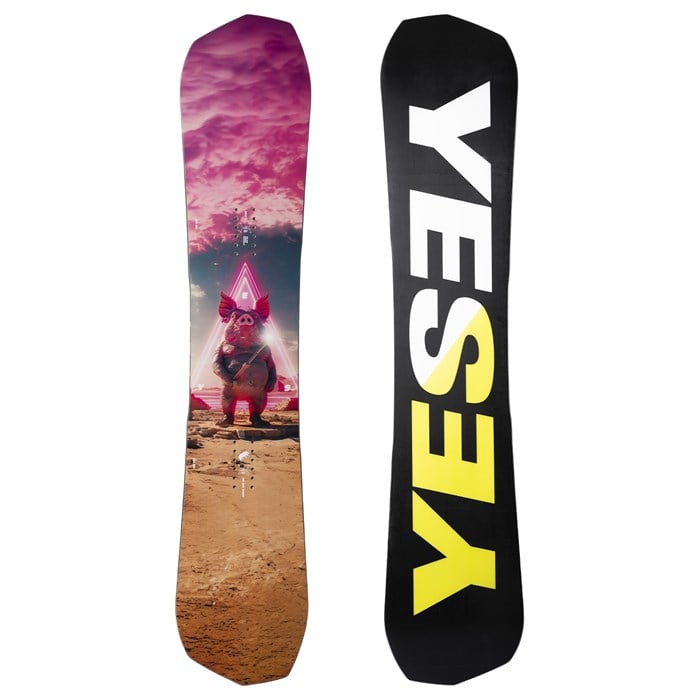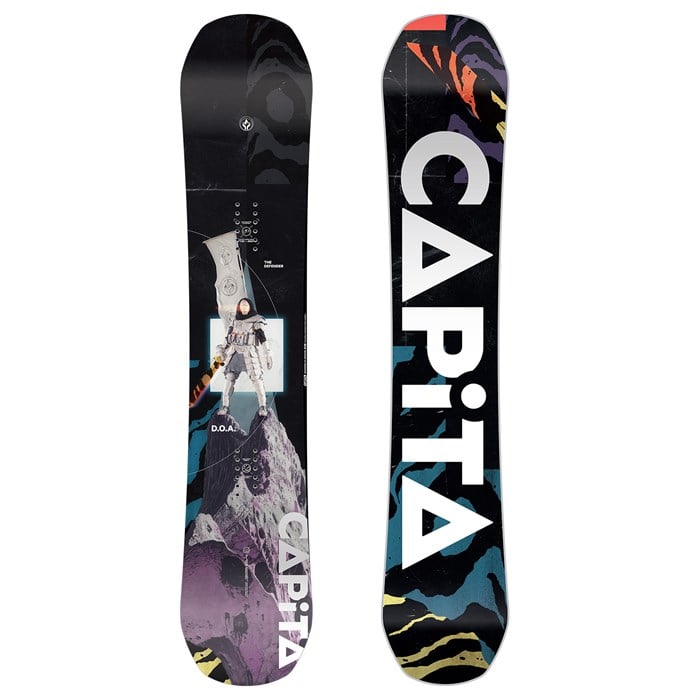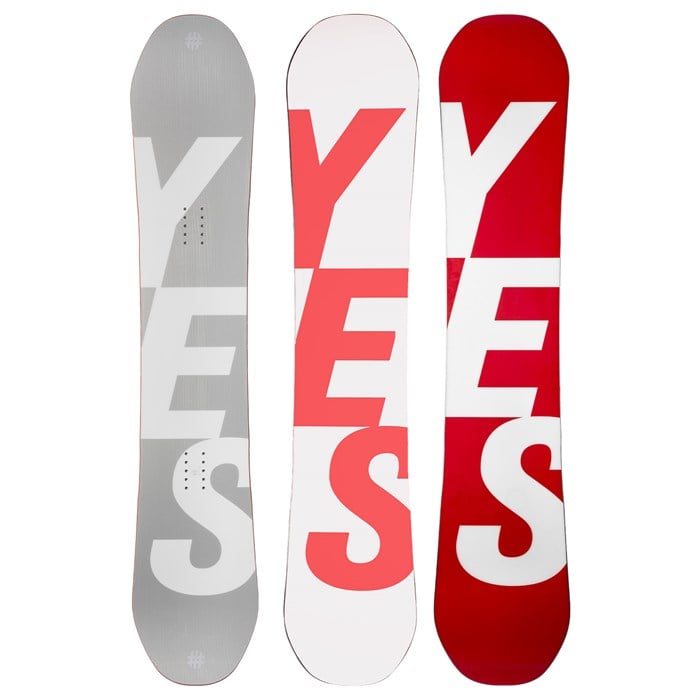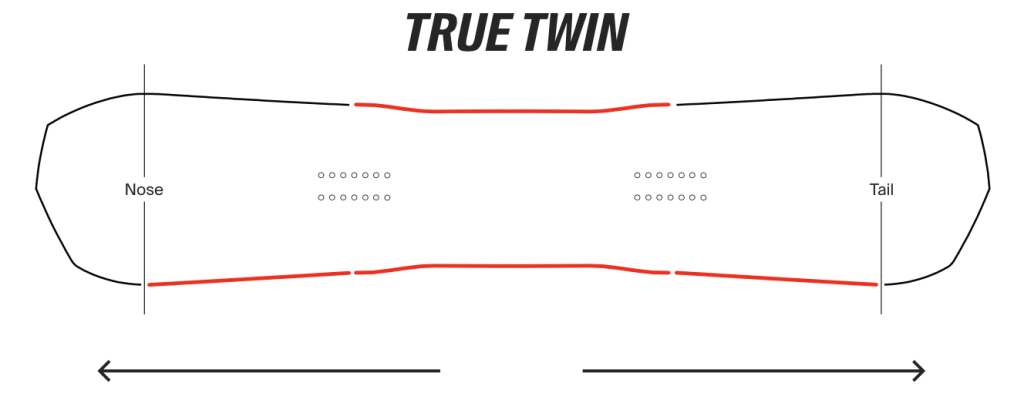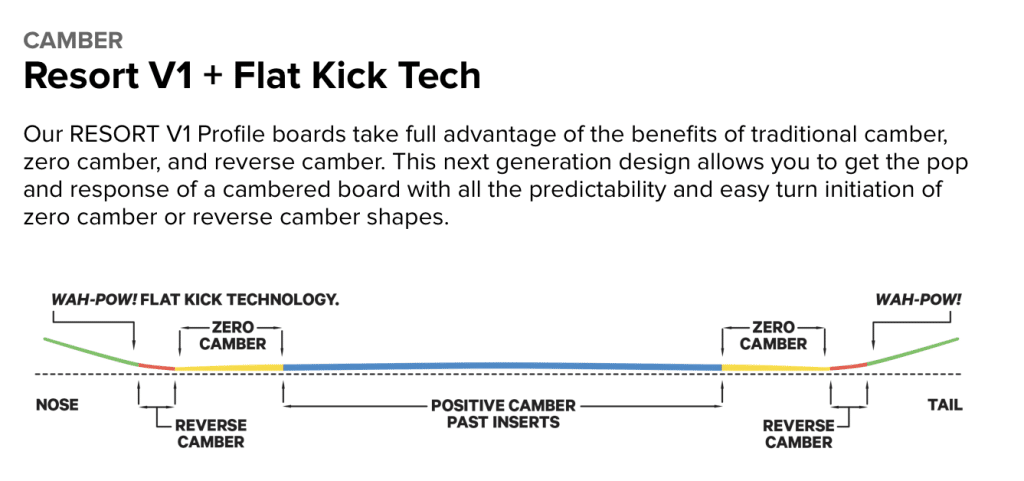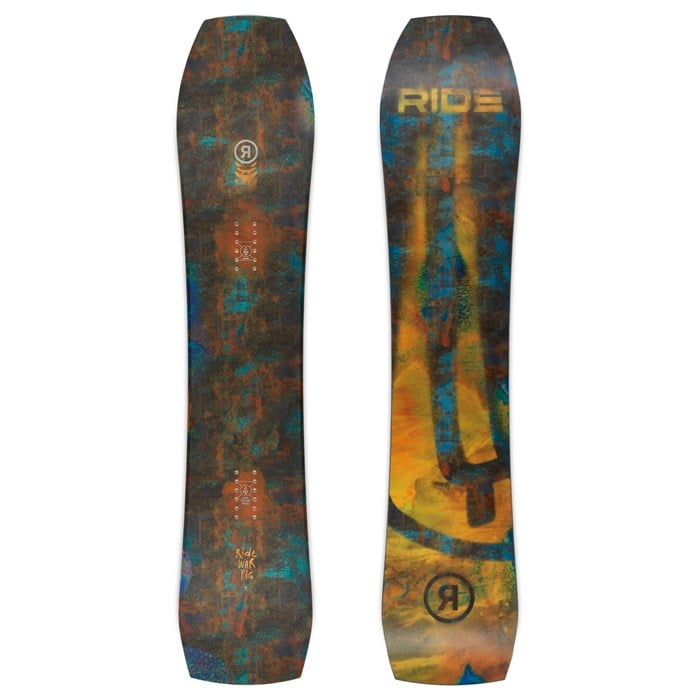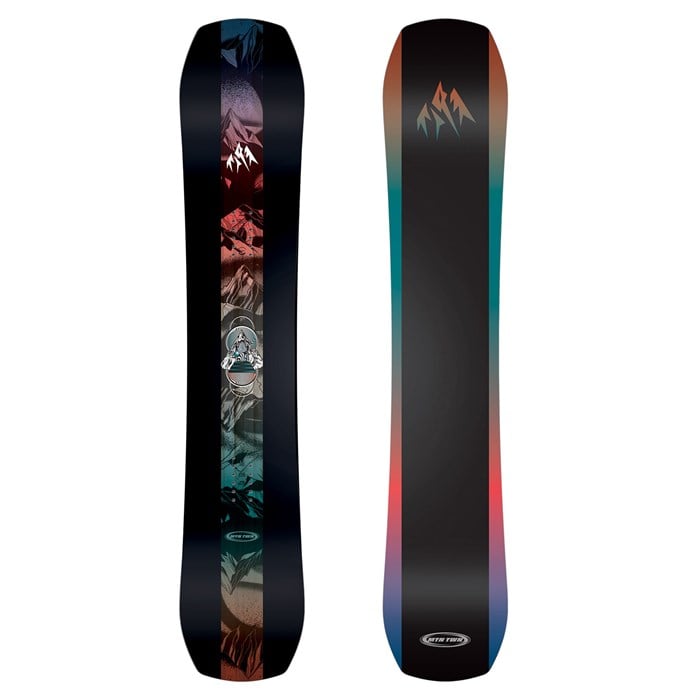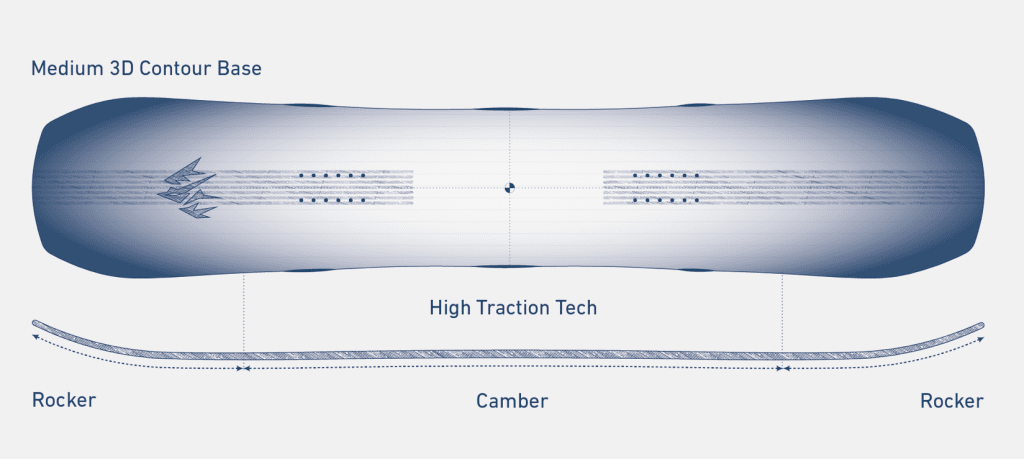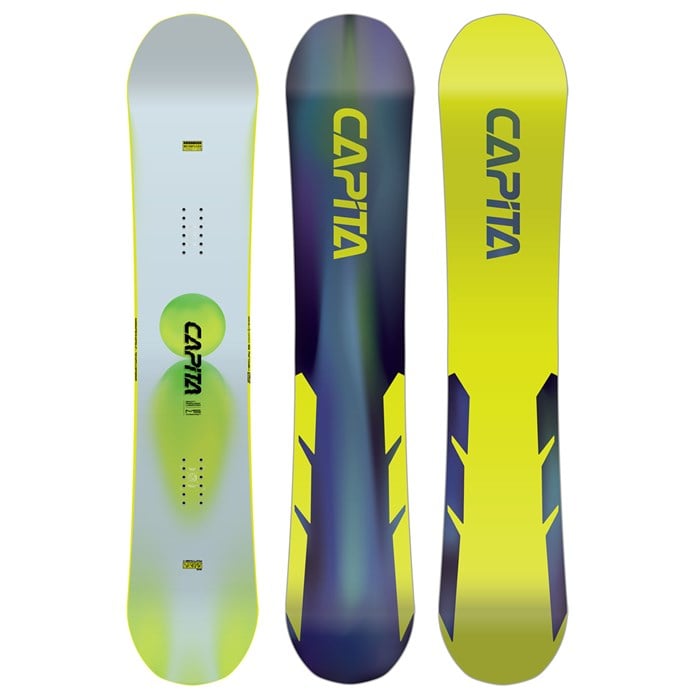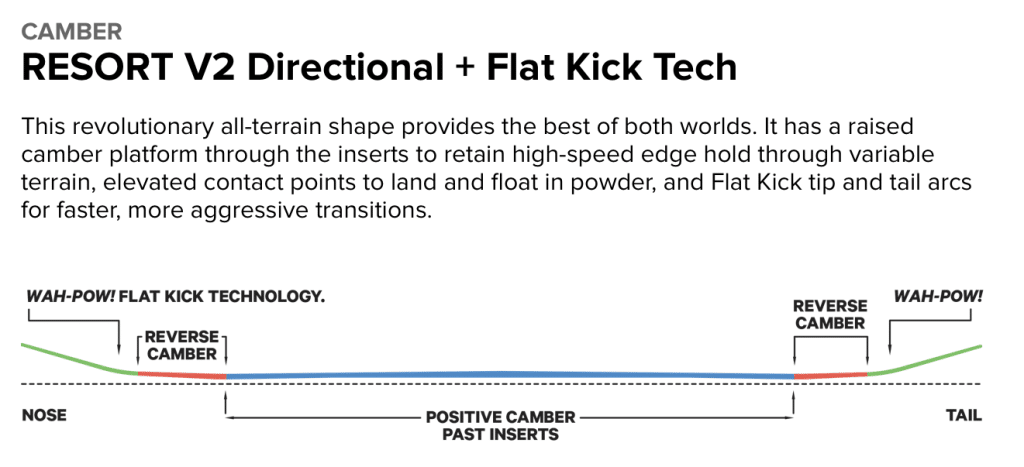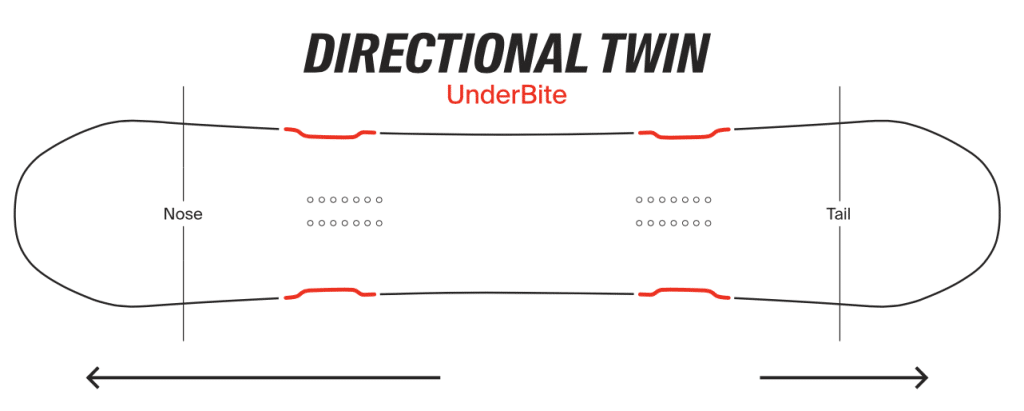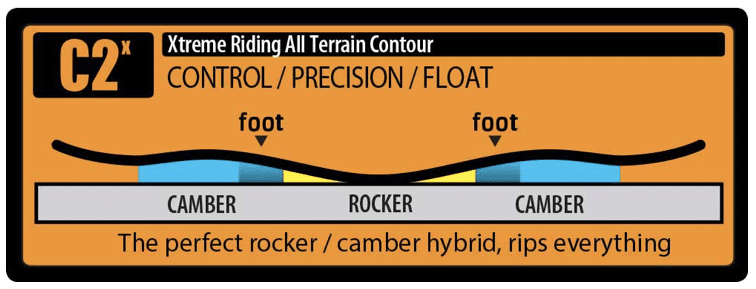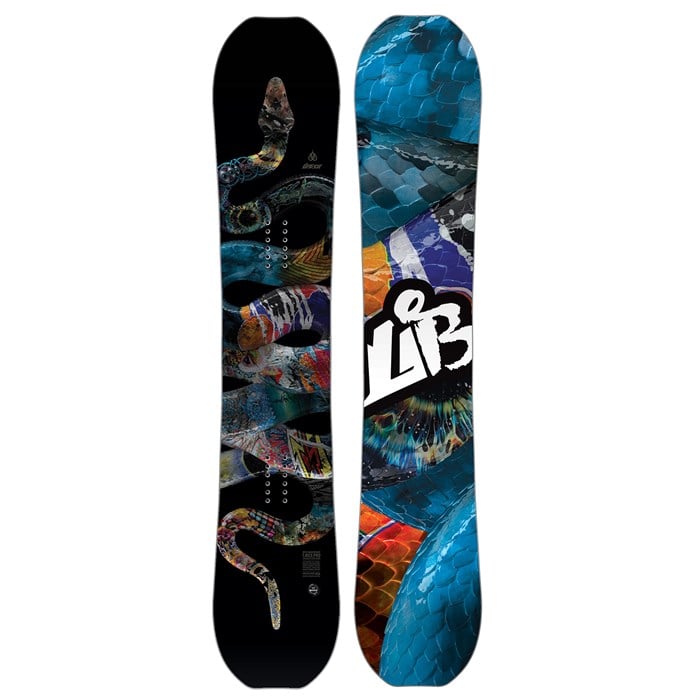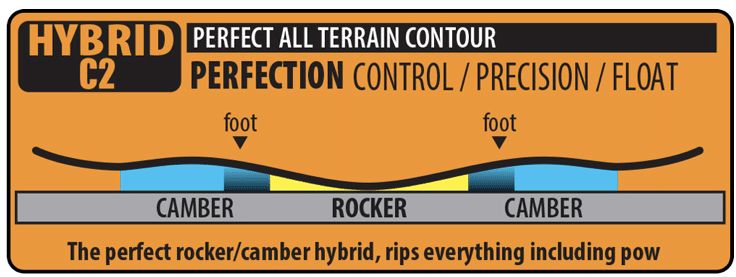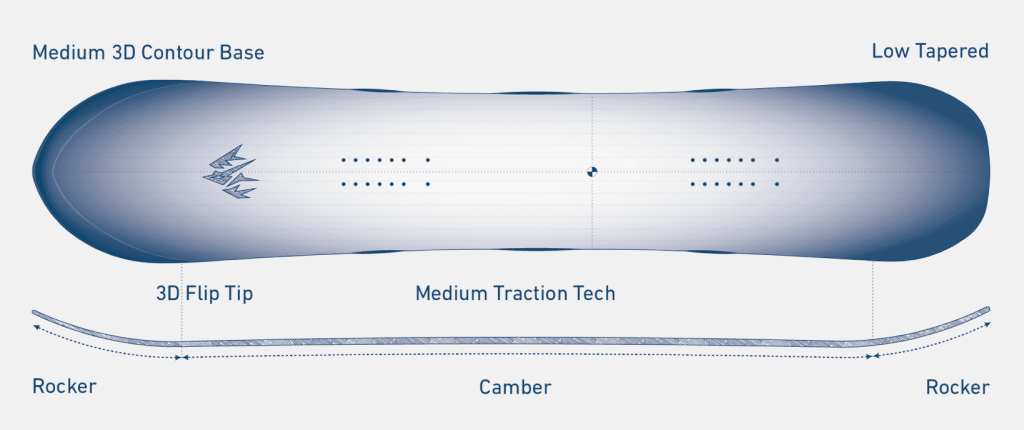If you’re hunting for the best all mountain snowboard of 2026, good luck. Brands will slap an all mountain sticker on anything these days. Half the time you end up with a park noodle pretending it can freeride, or a lifeless plank that only behaves on perfect corduroy.
But you came to the right place. I ride everything. I swap boards all season. If a board is bad, I find out fast.
A rare few actually hold up across the whole mountain. Groomers, chop, pow mornings, tight trees, ugly late day snow. These are the all-mountain boards worth considering.
🏆 Best Overall Pick
The Yes Greats Uninc is my go-to all-mountain board. It’s light, quick to turn and finds that rare balance of stability and playfulness. If I had to name the best all-mountain snowboard I’ve ridden in pre-season testing, this would be it.
My Top All-Mountain Snowboards
All-Mountain Reviews (2026)
1. Yes Greats Uninc Best Overall
- Flex: 7/10
- Profile: Hybrid Camrock
- Base: Sintered
- Shape: True Twin
- Pair: Burton Genesis
- Tech: Asym Midbite, Asymflex
Specifications
Asymmetrical twin with a medium stiff feel. Asym MidBite for stronger heelside engagement. CamRock profile with camber underfoot and rocker at the tips. Triax glass with carbon for snap. Poplar and paulownia core with bamboo stringers. Sintered base that stays quick when you keep it waxed. Flex reads about 7 out of 10. True twin so switch feels natural. I ride my regular length for playfulness and size up one if I want more top speed and carve power. Don’t go too big though, ruins the fun.
On Snow
1. Carving and Edge Hold
Heelside feels locked without feeling twitchy on toe. That is the whole point of Asym MidBite and it shows the second you lay it over on groomers. I can push hard across the fall line and it stays composed. Multiple shops and riders have preached to me about the edge bite and carving chops, and I agree.
2. Pop, Presses and Park
Camber between the feet gives you real pop. Rocker at the tips keeps it from feeling hooky on presses and side hits. Triax plus the bamboo stringers gives it rebound without feeling dead. Switch is a non-issue since it is a true twin. Great platform for butters given the extra width, and the unique shape isn’t catchy which I’d been worried about.
3. Stability and Speed
Flex reads 7 on paper, though most riders peg the torsional feel a touch softer. That matches what I felt in afternoon chunder. Hold it’s own but doesn’t require too much muscle. It’s not a tank, but it stays predictable and tracks well for a twin.
4. Powder
It’s not a dedicated pow stick. Set it back a touch and it still rides fine up to a moderate storm (though I’m always cautious to setback a twin, particular with the asymmetrical sidecuts). For an all-mountain twin, it does an admirable job. When it gets truly deep I grab something with taper or more nose.
Verdict
The Greats Uninc is the one all-mountain twin that actually rides well everywhere. Strong edge hold. Lively feel. Real pop without being twitchy. Not the choice for bottomless days, but for groomers, side hits and park laps it is a blast. If I had to name the best all mountain snowboard for riders who want a twin that carves hard and still feels playful, this stays on the short list.
Pros
- Excellent all-mountain performance
- Super fun and playful
- Asym tech boosts control
- Great pop for jumps
- Easy presses and butters
- Striking design
Cons
- High demand – sells out fast
- May be stiff for beginners
2. Capita Defenders of Awesome (DOA) Best Freestyle Pick
- Flex: 5.5/10 balanced for park and resort
- Profile: Resort V1 rocker camber rocker
- Base: Quantum Drive sintered
- Shape: True twin
- Pairs With: Rome D.O.D.
- Tech: Carbon fiber boosters, Kevlar sidewalls
Specifications
This little ripper has been topped lists for over a decade. It’s literally designed to be the most fun possible for the average resort rider.
The DOA is very much a traditional all-mountain freestyle deck. True twin with a medium flex. Resort camber profile with small rocker at the contact points. Camber underfoot for drive and pop. Biax and triax glass for a lively feel. Lightweight wood core with carbon and kevlar reinforcement. Fast sintered base. Flex sits around 5 to 6 out of 10. Centered stance and a sidecut that feels quick edge to edge. Runs true to size. I ride my regular length for park and all resort laps.
On Snow
1. Carving and Edge Hold
Better bite than most park-leaning twins. Feels clean on morning groomers and holds a carve if you keep the tune sharp. It prefers medium arcs over full trench warfare. Lacks the edge tech or asym features that many other top options use. I think the longer effective edge relative to the sizing (due to blunted tips) partially makes up for this – more hold than you’d expect for the given size.
2. Pop, Presses and Park
This is home turf. The DOA has some of the most accessible pop of any board I’ve ridden. Not the highest pop… but requires very little preload so you can boost side-hits with very minimal effort. The camber gives real snap for jumps too. Rockered tips keep presses and butters friendly. Stable on landings without feeling stiff or dead.
3. Stability and Speed
Handles resort speed fine. Tracks well until the snow turns to afternoon chop, then you feel some chatter. Not a big mountain charger, but not twitchy either.
4. Powder
Centered twin float is decent after a small set back. Fun for a storm or two. On the deepest days I’m ditching this for more nose and some taper.
Verdict
The CAPiTA DOA is popular for a reason. Overhyped? Sure. Fun? Hell yeah. It pops, it presses and it still carves well enough to be a daily driver. If your style is all-mountain with a freestyle flair, this one makes a ton of sense. If your plan is high speed chunder and steep lines all day, pick something stiffer and more directional.
Pros
- Iconic all-mountain performance
- Explosive pop and responsiveness
- Extremely fun to play around on
- Light swing weight for easy spins
- High-quality Austrian build
Cons
- Flex is softer than older models; Super DOA offers firmer ride
- Price has crept up in recent years
3. Ride Warpig Best Volume Shift
- Flex: 5/10
- Profile: Directional Zero Camber
- Base: Stone Ground Sintered 4000
- Shape: Directional, Tapered Bi-Radial Sidecut
- Pairs With: Cartel X bindings
- Features: Impact Plates, Performance Core, Slim Walls
Specifications
Short and wide directional shape. Volume shifted so you ride it much shorter than usual. Directional rocker with more rise in the nose. Flex about 6 out of 10. Sintered base. Performance core with carbon and impact plates. Urethane style sidewalls for a damp ride. Sizes run S to XL instead of standard lengths. I drop 6 to 10 cm from my normal board.
On Snow
1. Carving and Edge Hold
Way better than the shape suggests. The extra width gives strong leverage on edge. Happy in medium arcs and quick edge rolls. Heels feel locked once you trust the platform.
2. Pop, Presses and Park
More pop than expected. Stable takeoffs and landings thanks to width. Presses are fine once you find the sweet spot. Not a rail rat, but side hits are a blast.
3. Stability and Speed
Short length does not equal sketch. It tracks clean through resort chop and holds speed well. Not a freight train, but very composed for a stubby board.
4. Powder
Flat to rocker with a fat nose keeps it up. Set it back and it surfs. Easy float for storm days without much effort. Best powder performance of any option so far.
Verdict
The Warpig rides like a cheat code. Short, wide, quick to learn and far more capable than it looks. It carves, it floats and stays fun when the snow turns to junk. If you want a directional that still feels lively across the whole hill, this is the pick.
Pros
- All-mountain wildcard
- Fun, fast and lively
- Premium build
- Agile when sized down
- Poppy and snappy
Cons
- Slightly slower edge-to-edge due to width
- Feels a little heavier than average
4. Jones Mountain Twin Best Directional Twin
- Flex: 7/10
- Profile: CamRock hybrid
- Base: Sintered
- Shape: Directional Twin
- Pair With: Medium responsive bindings
- Tech: Traction Tech, 3D contour base
Specifications
Directional twin with a friendly medium flex. CamRock profile with camber underfoot and a touch of rocker at the nose and tail. Traction Tech for extra bite on hard snow. 3D base contour at the tips for smoother turn entry. Sintered base that holds wax and stays quick. I ride it true to size for a do everything resort setup.
On Snow
1. Carving and Edge Hold
This is why people love it. It rolls on edge easy, locks clean through the belly of the turn and gives real confidence on firm mornings. Heelside feels planted without feeling glued. I can get greedy with edge angle and it doesn’t chuck me.
2. Pop, Presses and Park
Camber gives real snap for side hits and jump lines. The flex lets you load it without fighting it. Tips are friendly for presses. Switch feels natural since the shape is balanced.
3. Stability and Speed
Predictable at pace. It tracks straight through resort chop and holds a line when the snow gets chewed. Not a bulldozer, just solid and calm. If you’re ridden other Jones boards, it’s quite a familiar feel.
4. Powder
Set it back a touch and it rides light on the front foot. The nose rocker helps it plane without drama. I still grab a more directional board for blower days, but this handles most storm cycles fine.
Verdict
The Mountain Twin is the answer for riders who want one board that plays everywhere. It carves, it pops, it stays composed when the hill gets rough. It’s maybe one of the truest “all-mountain” decks on the list, opposed to the slightly more freestyle orientated ones above.
If you are wondering about the Mountain Twin “Pro” (formerly the Ultra), think stiffer, stronger and pricier. I like the Pro when I plan to ride fast and hard all day. I reach for the Mountain Twin when I want the same DNA in a friendlier, easier daily driver.
Pros
- True do it all feel
- Strong edge grip on hardpack
- Easy to ride switch
- Real pop without fuss
- Ploughs through chop
- Great build quality
Cons
- Not as damp as the Ultra
- Tops out at very high speed
- Priced mid to high end
5. Burton Custom Camber Best Classic Camber
- Flex: 7/10
- Profile: Traditional Camber
- Base: Sintered
- Shape: Directional Twin
- Pair With: Medium stiff bindings
- Tech: Triax glass, tuned edge traction
Specifications
Directional twin feel with a medium stiff flex. Full traditional camber for drive and bite. Triax glass with carbon highlights for snap. Super Fly style core that keeps weight down without feeling hollow. Sintered base that holds wax and stays quick. The Channel for easy stance tweaks. I ride it true to size – definitely doesn’t need upsizing. The trad camber holds its own even at the lower end of my range.
On Snow
1. Carving and Edge Hold
This is where it shines. Clean entry, strong mid turn support and real bite on firm mornings. It rewards good timing. Keep the tune sharp and you can lean it way over without drama. Not for the lazy or fainthearted.
2. Pop, Presses and Park
Camber gives you that classic snap for ollies and jumps. It is happier on jumps than rails. Presses take some muscle but pay off once you find the sweet spot. Switch feels balanced enough for lines.
3. Stability and Speed
Calm at speed with a solid platform underfoot. Tracks straight through late day chop. Not a couch, not a noodle, just that classic locked in feel that lets you push.
4. Powder
Set it back and it rides fine up to a decent storm. The nose finds its way, though it’s not a surfy directional and traditional camber isn’t ideal here. For the deepest days I still grab something with more nose and taper.
Verdict
The Custom Camber is still the template. Precise, poppy and dependable when you want to actually ride the whole hill with intent. If you want the classic camber feel with modern build, this is it. If you prefer loose and buttery or surfy and tapered, look elsewhere. I reach for this when I want my board to answer every input and reliably give it right back. You might argue it lacks the “flair” or uniqueness of boards like the Greats or Warpig – fair comment – but “if it ain’t broke don’t fix it” appears to be Burton’s response. Also valid.
Pros
- Precise camber control
- Strong edge hold on hardpack
- Lively pop for jumps
- Calm and stable at speed
- The Channel makes stance tweaks easy
Cons
- Demands good technique
- Less forgiving for presses and rails
- Not surfy in deeper snow
6. CAPiTA Mercury Best Aggressive All-Mountain
- Flex: 6.5/10
- Profile: Resort V2 Directional
- Base: Sintered
- Shape: Directional, New Age
- Pairs With: Union Atlas bindings
- Tech: DEATH GRIP™ for edge control
Specifications
Directional twin with a medium stiff flex. Hybrid camber with camber between the feet and early rise at the tips. Lightweight wood core with carbon boosters for snap. Triax and biax glass for drive without killing feel. High grade sintered base that stays quick when you keep it waxed. I ride it slightly longer than my DOA, particularly if I plan to go fast all day.
On Snow
1. Carving and Edge Hold
This is the point. It locks in, feels planted through the belly of the turn and lets me push edge angle without washing. Heelside holds firm on early morning cord. It prefers real pressure over lazy riding. It beats the DOA for carving and speed.
2. Pop, Presses and Park
Camber gives serious snap for ollies and jumps. Landings feel solid and centered. It will press, but the flex wants intent. I treat it like a jump board first and a jib board second.
3. Stability and Speed
Calm at pace with a backbone you notice the first run. Tracks straight through chop and stays composed when the resort gets chewed. Not a couch, just confidently stiff in the right way.
4. Powder
Set it back and the nose stays up fine for most storm days. It is not a tapered surf stick, but it handles trees and wind buff without drama. Again, beats the DOA in this regard.
Verdict
The Mercury is the all mountain deck I grab when I want power everywhere. It carves hard, pops clean and shrugs off afternoon chop. If you live on side hits and rails, the DOA is easier. If you want a twin that feels built to charge and still ride the whole hill, the Mercury hits the sweet spot.
Pros
- Powerful edge hold
- Calm and stable at speed
- Big pop for jumps
- Tracks clean through chop
- Fast sintered base
Cons
- Not very forgiving for beginners
- Takes effort to press
- Prefers precise riding
7. Yes Basic Best Value
- Flex: 6/10
- Profile: CamRock hybrid
- Base: Extruded (durable low-maintenance)
- Shape: Directional Twin
- Pair With: Medium flex bindings
- Tech: UnderBite sidecut for edge grip
Specifications
Directional twin with a friendly medium flex. CamRock profile with camber between the feet and rocker at the tips. UnderBite sidecut for better edge hold without feeling catchy. Poplar core with rubber dampening touches. Extruded base – cheaper and marginally slower, but bombproof and holds wax much longer. I ride it true to size for all resort laps.
On Snow
1. Carving and Edge Hold
UnderBite gives legit bite on firm mornings. It rolls over easy and holds a medium arc without drama. Heelside feels calmer than most budget boards.
2. Pop, Presses and Park
Camber gives honest snap for side hits and small to mid jumps. Rockered tips make presses friendly. Switch is natural because the shape is essentially twin.
3. Stability and Speed
Predictable at resort pace. Tracks clean through late day chop better than the price suggests. Not a charger, not a noodle.
4. Powder
Set it back a touch and it floats fine for a storm or two. For the deepest days I still want more nose and some taper.
Verdict
If you want the best mix of performance and price, the YES Basic is the move. It grips, it pops and it stays calm when the snow turns to junk. A super dependable option that sticks to the budget without resorting to cheap materials. Buy it once, ride it everywhere.
Pros
- Real edge hold for the price
- Easy to ride yet not dull
- Friendly for presses and side hits
- Way more tech than similarly priced boards
- Predictable in chop
- Wide size run and easy sizing
Cons
- Not a high speed charger
- Base slower than sintered picks
- Less pop than stiffer camber decks
8. Gnu Rider's Choice Best Pro Pick
- Flex: 5.5/10
- Profile: C2X rocker camber rocker
- Base: Sintered Knife-Cut
- Shape: Asym twin
- Pairs With: Medium flex bindings
- Features: Magne-Traction, ASYM Level 2
Specifications
Asym twin with a medium flex. C2X hybrid profile with mild rocker between the feet and camber under each foot. Magne-Traction for extra bite on firm snow. Asym sidecut and flex for a stronger heelside. Eco-sublimated sintered base that stays quick with regular wax. I ride it true to size.
On Snow
1. Carving and Edge Hold
The combo of Magnetraction and the asym heelside is freaking awesome. Toeside feels clean and precise. Heelside locks harder than most twins without feeling catchy. I can lean it over on morning cord and it holds a very high line.
2. Pop, Presses and Park
Camber underfoot gives real snap for ollies and jump takeoffs. Rocker between the feet keeps it from feeling hooky on presses and butters. Switch is natural since the shape is balanced.
3. Stability and Speed
Calm enough to run fast laps. Tracks straight through push piles better than you expect from a playful twin. Not a bulldozer, but solid and predictable when the resort gets chopped.
4. Powder
Set it back a touch and it rides fine for a storm or two. The twin shape still feels playful in trees. For true deep days I grab something else. Not a criticism – it’s an all-mountain slayer, not a powder deck.
Verdict
The Riders Choice earns its name. It was built with heavy pro team input and it shows on snow. Real edge hold on hardpack, easy heelside carving and lively pop without being stiff. Pros back it because it works on real resort days, not just park laps. If you want a twin that grips hardpack, hits side hits and still feels fun on jump lines, this is a smart pick. If you need maximum damp or pure freeride float, go stiffer and more directional.
Pros
- Magne-Traction grip on hardpack
- Asym heelside feels effortless
- Real pop for jumps and side hits
- Playful for butters and switch
- Stays composed in resort chop
- Really solid all-mountain performer
Cons
- Not the dampest at very high speed
- Can feel grabby if edges are not detuned
- Less ideal for a heavy rail focus
9. Lib Tech T. Rice Pro Best All-Mountain Freeride
- Flex: 7/10
- Profile: C2 hybrid
- Base: Sintered
- Shape: Directional Twin
- Pairs With: Medium stiff bindings
- Tech: Magne-Traction edges
Specifications
Directional twin feel with a medium stiff flex. C2 hybrid profile with more rocker between the feet and mellower camber under foot compared to the C2X. Magne-Traction edges for bite on firm snow. Aspen and paulownia core with basalt for snap and damp feel without deadening it. Eco-sublimated sintered base that stays quick with regular wax. I ride it slightly longer than other options, as I know I’ll be pushing harder and faster.
On Snow
1. Carving and Edge Hold
Magnetraction bites early and stays locked when you tip it over. Toeside feels precise. Heelside holds without micro drift. It likes clean, committed arcs and rewards pressure through the belly of the turn.
2. Pop, Presses and Park
Real snap for ollies and big takeoffs. Landings feel centered and secure. It will press, but it prefers jumps and fast side hits over slow butter laps.
3. Stability and Speed
This is the reason to buy it. It tracks straight in late day chop and keeps calm when the pace creeps. I can point it through bumps and it does not get nervous.
4. Powder
Set it back and the nose rides light. Trees feel controlled and predictable. It is not a tapered surf stick, but it handles most surprise powder dumps fine.
Verdict
The T. Rice Pro is the board I grab when I know the day will be fast. Edge hold is real, landings feel solid and it stays composed when the resort gets chewed up. If you want something looser and more playful, DOA or Riders Choice fits better. If you want a board that keeps its head at speed and still rides the whole hill, this is the pick.
Pros
- Magne-Traction grip on hardpack
- Asym heelside feels effortless
- Real pop for jumps and side hits
- Playful for butters and switch
- Stays composed in resort chop
Cons
- Deep powder still wants more nose
- On the heavier side
- Less park-friendly than other picks
10. Jones Frontier 2.0 Best Powder Option
- Flex: 6/10
- Profile: CamRock hybrid
- Base: Sintered 8000
- Shape: Directional with set back
- Pairs With: Medium flex bindings
- Tech: Traction Tech, 3D Contour Base
Specifications
Directional shape with a set back stance. CamRock profile with camber underfoot and rocker in the nose and tail. 3D contour at the nose for smoother planing. Traction Tech along the edges for bite on firm snow. Sintered base that stays quick with regular wax. Flex sits right in the middle. I ride it true to size for resort days or size up one if I know it is going to nuke.
On Snow
1. Carving and Edge Hold
Easy roll in, clean mid turn support and real grip when the cord is firm. Traction Tech keeps it from washing when you get greedy on edge. It likes medium arcs and stays calm if you push the tail.
2. Pop, Presses and Park
Playful flex and lifted nose make butters and side hits feel natural. Camber gives honest snap for small to mid jumps. Switch is fine for occasional laps even if it is not the focus.
3. Stability and Speed
This is where the limits show. At higher speeds the nose can chatter and afternoon chop can buck it around if you plow straight through. Keep it smooth and it stays predictable.
4. Powder
This is why we’re here! Set it back and the nose rises fast. The spooned tip helps it stay loose and surfy in trees. I can ride my normal length and still float on storm mornings. Excellent powder performance for an “all-mountain” deck.
Verdict
Frontier 2.0 is the groomer cruiser that opens up the mountain for progressing riders. Playful on side hits, easy to butter and happy in soft snow. It is not built to go mach six or smash through heavy chop, and that is fine. If you want a friendly daily that floats on storm days and still carves clean when the sun comes out, this is the one I point people to. If you want a twin that lives in the park, grab DOA or Riders Choice. If you plan to charge hard all day, Mercury or Custom hits harder. For a powder friendly daily that still rides the whole hill, the Frontier just works.
Pros
- Easy float with set back and nose rocker
- Good edge hold for firm mornings
- Smooth and predictable in chop
- Still playful on side hits
- Low learning curve for progressing riders
Cons
- Not as damp as true freeride tanks
- Less pop than stiffer camber twins
- Switch is fine but not its focus
- Deepest days still reward a longer size
Comparison Table
| Snowboard | Flex | Profile | Base | Shape | Pair With | Riding Style | Score | Price |
|---|---|---|---|---|---|---|---|---|
| YES Greats Uninc | 7 | Hybrid CamRock | Sintered | True Twin | Burton Genesis | All-Mountain / Carving | 9.5 | $699 |
| CAPiTA DOA | 5.5 | Resort V1 (Rocker/Camber/Rocker) | Quantum Drive Sintered | True Twin | Rome D.O.D. | All-Mountain Freestyle | 9.3 | $649 |
| Ride Warpig | 5 | Directional Zero Camber | Sintered 4000 | Directional (Tapered Bi-Radial) | Burton Cartel X | All-Mountain / Freeride | 9.2 | $549 |
| Jones Mountain Twin | 7 | CamRock Hybrid | Sintered | Directional Twin | Medium responsive bindings | All-Mountain | 9.2 | $629 |
| Burton Custom Camber | 7 | Traditional Camber | Sintered WFO | Directional Twin | Burton Cartel / EST | All-Mountain / Carving | 9.1 | $679 |
| CAPiTA Mercury | 6.5 | Resort V2 Directional | Sintered | Directional | Union Atlas | All-Mountain / Freeride | 9.0 | $699 |
| YES Basic | 5 | CamRock Hybrid | Extruded (low-maintenance) | True Twin | Medium flex bindings | All-Mountain Value | 8.9 | $449 |
| GNU Riders Choice | 5.5 | C2X (Rocker/Camber/Rocker) | Sintered | Asym Twin | Medium flex bindings | All-Mountain Freestyle | 9.3 | $629 |
| Lib Tech T. Rice Pro | 7 | C2 Hybrid | Sintered | Directional Twin | Medium-stiff bindings | All-Mountain Freeride | 9.1 | $699 |
| Jones Frontier 2.0 | 6 | CamRock Hybrid | Sintered | Directional (Setback) | Medium flex bindings | Powder-Friendly All-Mountain | 8.8 | $549 |
All-Mountain Snowboard Buyer’s Guide
You want one board to ride the whole hill. Same. I teach, guide and I’ve sold a lot of these in my former shop tech days. Here’s how I help riders land on the right deck without wasting a season.
Fit First
Length is simple. Just plug your stats through our snowboard size calculator. If you love fast groomers or chase fresh powder, lean a touch longer. If your day is side hits, trees and quick turns, lean a touch shorter. Stay inside the brand’s weight range for your size when able. If you’re near the top of that range, the longer option usually rides cleaner.
Width Matters Too
Boot size decides waist width. You want just a little toe and heel overhang. Too narrow and you’ll drag on hard carves. Too wide and the board feels slow edge to edge. Quick rule I use on hill: boot sizes US 10 and above should consider a mid-wide, 11 and above a wide.
Boot outsole length varies by brand too. A bulky size 10 can need the same width as a slim 10.5.
Binding angles matter. More angle reduces overhang. Flat stances need a bit more width.
Choose Flex Wisely
Soft feels fun in the shop. Then it chatters when you point it. Medium is the classic daily driver. It presses, it carves, it does not fold. Medium stiff holds speed and edge better but asks for cleaner technique. If you like to go fast or you’re heavier for your height, don’t be scared of a bit more backbone.
Camber Profiles (in plain English)
Full camber bites hard and pops clean. It rewards good habits. Hybrids with rocker between the feet and camber under each foot are the easy win for mixed resort days. Flat to rocker turns on autopilot and floats fine, but it will not grip like camber when things get dicey. Pick for your hill, not the catalog.
Shape and Stance
Twins are great if you ride a lot of switch or spend time in the park. Directional twins are the best “ride-everywhere” choice for most people. They still ride switch, they just feel more confident on edge. Add a small setback on storm days and you get float without giving up your groomer fun. If you live for soft snow, a light touch of taper helps the tail release and keeps the nose up.
Edge Tech and Bases
Bumped or wavy edges add bite on hardpack. Handy if your home hill gets icy. Sintered bases are faster when you actually wax them. Extruded is slower but easy to fix and fine for value boards. If speed matters to you, keep a sintered base fed and it will reward you every lap.
Bindings and Boots
Match flex across the setup. Medium board with medium bindings is the safe call. Stiffer bindings sharpen response. Softer keeps it playful. Center your boots on the board, check overhang and make sure your stance width feels right before you torque everything down.
Sizing Examples
If your plan is side hits and quick trees, ride the shorter end of your size range. If your plan is fast groomers and late-day chop, ride the longer end. If you booked a pow trip, run your freeride size with some setback or go up two centimeters if you like to carry speed.
Common Mistakes
Buying too soft because it feels nice on carpet. Ignoring waist width and ending up with heel drag. Choosing a pure park twin when you barely ride park. Running a sintered base dry and wondering why it feels slow. Wax your board!
Your Quick Checklist
1. Pick your bias: freestyle, carving or powder.
2. Choose a profile to match it: camber for bite, hybrid for balance, flat-rocker for ease.
3. Lock in your Shape: twin for switch, directional twin for daily use, directional for speed and float.
4. Match flex to how fast you ride and where you sit in the weight range.
5. Confirm waist width from your boot size (or our size charts).
If you’re stuck between two sizes, think terrain. Tighter terrain likes a shorter board. Open trails and tracked afternoons like the longer one. That rule has saved more riders than any spec sheet ever did.
Final Thoughts
Most boards claim all-mountain. Only a few actually earned it. You’ve got them above.
Still here? Pick one. You’ll be fine.
One board to do it all and still carve clean? YES Greats Uninc.
Freestyle daily that suits most riders? CAPiTA DOA.
Want power and speed without riding a plank? Lib Tech T. Rice Pro.
What I’m riding this season: Greats Uninc most days. Mercury when I want to push. A real pow board when it’s stacking.
That’s it. Pick one, set your stance, don’t overthink it. Have fun.
Oh, and sorry for calling you a loser. You got this.
All-Mountain Snowboard FAQs
- Full camber: best bite and pop. Less forgiving.
- Rocker between feet + camber underfoot: balanced and stable for mixed conditions.
- Flat to rocker: easy turn start and floaty feel. Less grip on ice.
Match it to your hill. I grab camber or hybrid for firm, icy days, reserving rocker for when it is soft.
Chin to nose works for most, though this advice is fairly outdated. Use our Snowboard Size Calculator.
Size up 1–3 cm for speed or powder. Size down 1–3 cm for trees and side hits. Stay inside the brand’s weight range. Near the top of the range, the longer option usually rides cleaner.- Buying too soft, then hating the chatter
- Ignoring waist width and getting heel drag
- Choosing a pure park twin when you barely ride park
- Running a sintered base dry and calling it slow
- Oversizing volume-shift boards so they feel dead edge to edge

